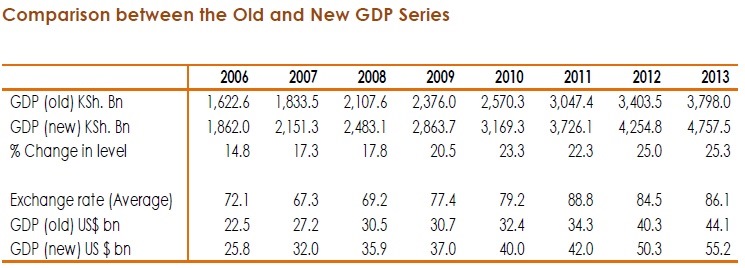News
Kenya: Highlights of the revision of National accounts

Kenya National Bureau of Statistics (KNBS) initiated the process of rebasing and revision of the National Accounts Statistics in 2010. Specific tasks were to implement some of the recommendations contained in 2008 System of National Accounts (2008 SNA), change the base year from 2001 to 2009 and, revise the annual and quarterly national accounts statistics for the period 2006 to 2013. In addition, the revision was to include for the first time the development of Supply and Use Tables (SUT) as an integral part of the National Accounts Statistics. The Supply and Use Tables gives detailed information on the production processes, the inter-dependencies in production, the use of goods and services and the generation of income in production. The SUT was used as a framework for the revision process. This was published in the 2014 Economic Survey report. Also presented in the same report were the preliminary revised GDP estimates for 2009 and have since been firmed up.
Broadly, the revision process involved use of a wide range of information obtained from surveys, censuses and administrative records. This was done in a coherent and consistent manner to achieve the overall goal of improved National Accounts statistics.
Rebasing of national accounts series means replacing the old base year used for compiling the constant price estimates to a new and more recent base year. It is essentially done to ensure that the principal measure of economic growth yields good estimates over the medium term following the base year. It is desirable to periodically rebase, to update the production structure; structural changes in relative prices of various products and; incorporate product changes due to developments and innovations. In addition, changes on the demand side like consumption patterns, utilization and acquisition of capital goods are all also updated through such a process. Rebasing is used to account for these changes, so as to give a more current snapshot of the economy.
This is the sixth time that Kenya has revised the National Accounts Statistics. The first official estimates of domestic income were prepared in 1947. The first revision was carried out in 1957 after a number of surveys were conducted to fill in the data gaps. Subsequent revisions were carried out in 1967, 1976, 1985, 2005 and 2014.
The revised GDP estimate translates to 20.5 per cent increase in the level of 2009 GDP and rises to 25.3 percent in 2013. The main contributing factors included improved coverage and revised input-output production structures which were lower in a number of sectors compared to the revised estimates. The use of new data such as 2009 Kenya Population and Housing Census (KPHC), 2005/06 Kenya Integrated Household Budget Survey (KIHBS) and 2010 Census of Industrial production (CIP) majorly contributed to the upward revisions.
Real estate, agriculture and manufacturing account for most of the change. Despite this, there are no dramatic differences in the structure of the economy in broadly defined categories. In contrast to many countries, the share of agriculture to GDP has remained relatively unchanged over the period.
Extracts taken from “Information on the Revised National Accounts”, published on 30 September 2014 by the KNBS.

Related media items:
-
ECA welcomes the rebasing of the Kenyan economy - UNECA, 10 Oct 2014
-
Principal benefits of rebasing economy - Mohamed Wehliye (Standard Digital, 2 Oct 2014)
-
Middle-income mirage: New status won’t shelter economy from raging headwinds - Jackson Okoth and James Anyanzwa (Standard Digital, 30 Sep 2014)
-
Forget the hype about Kenya turning into a middle-income economy soon - Rasna Warah (Daily Nation, 28 Sep 2014)




